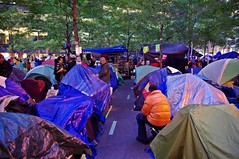Occupy Wall Street Meets the Tea Party: A Little of the Human Touch

By Tom Watson
For all the splashy immersion in code, data, platforms, and techniques that generally soaks the discussions and analysis of the democracy and civil rights movements among the digerati, it was striking how little technology asserted itself last night at Personal Democracy Media’s “instant” conference on Occupy Wall Street and Tea Party organizing at New York University.
While the network itself was at the center of the rangy panel discussion, there was little on Facebook and Twitter, text messaging and video platforms from those on the stage, and not much from the audience either. This was surprising in some ways, because from where I sat, the 10th floor of the Kimmel Center was basically Geek Central, East Coast Chapter, convened by Micah Sifry and Andrew Rasiej.
Yet the web seemed almost a side player, a stipulated tool in the hands of craftspeople making something shinier and more valuable. To some, it was the network itself, with a perfect circle of actor/activists signaling the highest purpose of our digital connections. This is a standard point of view among those convinced that social networks and the digital ties that bind necessarily offer a brighter future for democracy and the public commons.
But there was another factor in last night’s discussion of how Occupy and the Tea Party captured hearts and minds and moving feet that clearly rivaled the network and its much-studied effect: human empathy.
To my ear, speaker after speaker stressed the appeal of an empathetic connection within organizing groups to challenge the powers that be.
“Communities and networks are becoming communities of care–we care for each other space,” said grassroots organizer Marianne Manilov, co-founder and co-director of The Engage Network. She said much of the success of Occupy’s core group of organizers came from their collective realization that in today’s society, “there’s no one coming for us.” Pulling together into “small circles of trust “ isn’t a technique – it’s a necessity, she said. “People are coming together and they’re re-knitting the broken fabric of our broken communities by standing together.”
Jessica Shearer, executive director of SEIU ‘s Healthcare Education Project and a veteran political organizer, talked with disarming directness about organized labor’s lack of the human touch. She told of fleeing the scene of domestic violence as a child, and how her mother had called the union for help. “No response. Not a single word. Not ever. In desperation she turned to the evangelical church. By nightfall we had a place to stay and a turkey stew.”
Shearer said that big unions like SEIU struggle to reach people in real ways, and really empower their members. “Everywhere unions stagnate, we shrink. Unions fall victim to our own scale and sophistication. We know that Occupy is important but we’re still learning our lesson.”
She contrasted organized labor’s response to the Tea Party and said that while unions were altogether smarter and more sophisticated with their “large professional call centers and mass mailings,” the truth was that “the Tea Party, you” – turning to California Tea Party Patriots founder Mark Meckler, who sat next to her on the dais – “kicked our butts.”
Shearer talked about the October 5 march in New York, when organized labor first endorsed Occupy Wall Street and swelled its numbers to more than 12,000 marchers (including me). A month later on November 17, the crowd grew to more than 30,000 people including major union leaders. But she pointed out that those numbers, while large for the Occupy movement, are tiny compared to the millions of potential boots on the ground. What’s lacking still, Shearer asserted, is the visceral connection to people, to members, to workers who might want to organize: “Labor is on the edge of a cliff. What we lack – what we feel we can no longer afford – is human scale outreach.”
The crowds in Tahrir Square in Cairo just might have the opposite problem, according to social analyst Zeynep Tufekci of the University of North Carolina, who has spent time with the networked revolutionaries and written about freedom movements on her technosociology blog. The Egyptian freedom activists gravitated toward the rewarding and now-familiar human interaction at Tahrir, missing their moment in the recent elections. Tufekci scratched a bit at the sacred hide of “the network” during her talk, worrying aloud that small groups of organizers can fall in love, in essence, with organizing itself and their own perfectly-formed (and basically closed) circles, while ignoring models like the U.S. civil rights movement which, led by goal-oriented visionaries, plunged ruthlessly on in pursuit of legal and societal change – and succeeded. Yet she couldn’t help but tell the wonderful tale of the Twitter-powered creation of ad hoc field hospitals in Cairo to treat the hundreds of casualties from the clashes with authorities.
But the three organizers who ran the field hospital creation network weren’t faceless drones in a network in which each member is an exact equal. They were leaders – just as there are leaders of the Occupy movement and the Tea Party, whether they accept those monikers or not. Some of it is indeed based on hubs of information and sharing data. Author and NYU professor Clay Shirky remarked (correctly in my view) that “the person who collates information often becomes the go-to person.” And despite being the only self-identified Tea Party member in the room, Mark Meckler elicited a sea of nodding liberal heads when he said that these movements “are not leaderless, they’re ‘leaderfull.’”
Meckler painted a different painting of Tea Party organizing than is generally accepted by progressive critics – one that reflects both a sharing ethic among organizers and a lack of support from the big institutions (the national GOP, Fox News, and the Koch Brothers made their appearances in discussion and on the Twitter feed for the event). His description closely aligned with the vision of Ori Brafman, co-author, The Starfish and the Spider – the concept of “emergence” and the bubbling up of movements from “starfish” organizations that regenerate their myriad parts and adapt. In a digitally networked world, asserted Brafman, “this is going to be the platform for activism going forward.” In Brafman’s “small circles of trust” the technology drops away.
Occupy organizer Beka Economopolous brought the broad sociological concepts down from 30,000 feet to the pavement in Zuccotti Park. “What’s great about OWS is that it gets people out of their houses and off their computers,” she said. Occupy has a strong sense of its own dramatic presence to the left – “we stage defiance and sacrifice and that captures people’s imaginations.” And at some level, it’s about “touching people’s hearts and fulfilling peoples needs.”
Shirky had the take-away question in my view: at what point, if ever, does Occupy “go all the way” in altering our relationship with government? Or better stated, in a democratic republic, when does it change government – since we have no relationship in theory.
The answer’s unclear, of course. Yet it was heartening to me to hear Shearer’s account on the burgeoning impact of Occupy on organized labor. It’s not quite that the Occupiers are standing over an operating room gurney, charging a couple of electronic paddles, and yelling “clear!” Maybe it’s closer to an ice cold Gatorade to a long distance runner. But I had to agree with her conclusion:
“Occupy Wall Street is not an alternative to real organizing – it is real organizing.”
[Image credit: Brian Sims, Creative Commons.]









